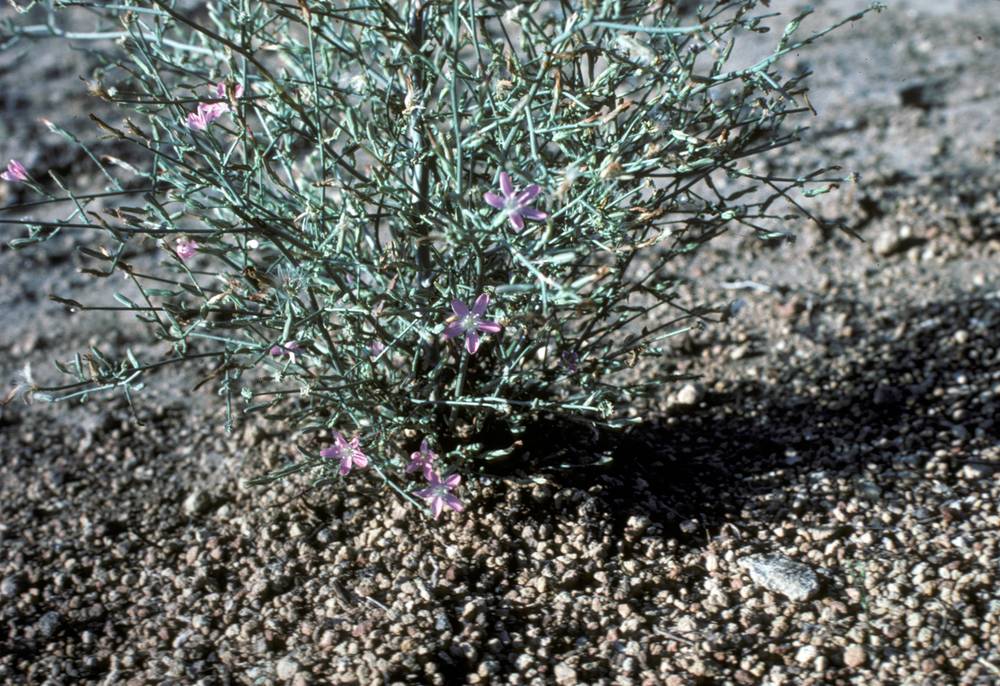
Plants annual, 10–50+ cm.
Stems glabrous or sparsely pubescent.
Leaves basal and cauline; basal withering by flowering, linear to oblanceolate, 3–10 cm, margins toothed or sparingly lobed, surfaces glabrous; cauline reduced to bractlets in inflorescences, mostly linear.
Inflorescences panicle- or raceme-like arrays.
Peduncles 1–40+ mm.
Involucres cylindrical to narrowly campanulate, 5–10 mm, surfaces glabrous or puberulent.
Phyllaries inner 4–8, linear-lanceolate; outer mostly basal, deltate to lanceolate, loosely reflexed.
Florets 5–11; ligules 10–15 mm, pink to peach-colored.
Fruits 2.5–3 mm, light tan to dark brown, grooved and roughened between ribs; pappus bristles 5–24, white or tan, plumose on distal 60–80%, distal portion deciduous.
2n=16.
Juniper woodlands, sagebrush scrub, open slopes, flats, dunes, cultivated fields. Flowering May–Sep. 100–1500 m. BR, ECas, Lava, Owy. CA, ID, NV; south to Mexico. Native.
There is considerable intergradation between the subspecies of Stephanomeria exigua. In eastern Oregon, some plants may show intermediate characteristics between subspecies coronaria and subspecies exigua. Typical subspecies coronaria from the California Coast Range has heads on short (10 mm or less) peduncles, forming a raceme on the inflorescence branches; however, the intermediate plants have a more panicle-like arrangement with some heads on peduncles more than 10 mm long mixed with those on shorter peduncles. To simplify this treatment, we are considering such plants to be referable to subspecies coronaria, since no typical subspecies exigua (with all peduncles more than 10 mm) has been identified in the state.
as described under Stephanomeria exigua ssp. coronaria
Heads borne singly or clustered along branches. Peduncles 2-5 mm, glabrous or puberulent . Calyculi of appressed bractlets. Involucres glabrous or puberulent. Florets 5-11. Cypselae 2.3-3.1 mm; pappi of 7-20 bristles (widened bases persistent, bases connate in groups of 2-4, bristles plumose on distal 60-85%). 2n = 16.Flowering Jul-Oct. Equable sites along California coast, sandy meadows in South Coast Ranges, sandy soils of Central Valley, openings in yellow pine forest, volcanic soils in eastern Sierra Nevada, sandy, limestone, or volcanic soils in sagebrush deserts; 0-2800 m; Calif., Idaho, Nev., Oreg.Subspecies coronaria occupies the widest range of habitats of any annual stephanomeria, and it shows striking morphologic variability for some characters including number of florets, lengths and widths of corollas. numbers and plumosity of pappus bristles, and degree of 'bumpiness' of faces of the cypselae. Populations from the eastern slopes of the Sierra Nevada in California to the mountains of Nevada, central Oregon, and Idaho vary most evidently toward subsp. exigua, native to the deserts, in having heads on longer peduncles, making a quite different architectural appearance than characteristic of the plants with nearly sessile heads in the Coast Ranges and elsewhere in California. The variation in subsp. coronaria presumably results from hybridization with subsp. exigua where the two subspecies make contact at intermediate elevations. Hybrid individuals are readily identifiable wherever subsp. coronaria makes contact with other subspecies of S. exigua (L. D. Gottlieb 1971, 1972).